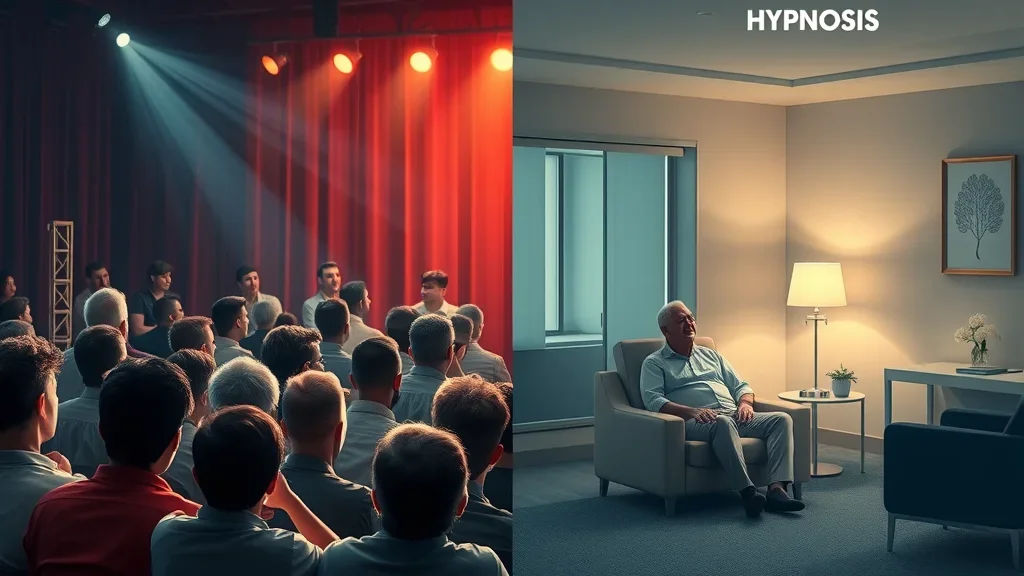"Did you know that over 15% of people are highly responsive to hypnosis, according to recent clinical studies?" This surprising fact challenges common beliefs about hypnosis and hints at a rich body of science behind this misunderstood tool. Far from being magic or mind control, hypnosis is grounded in rigorous research and supported by professionals across the world. If you’re ready to uncover exactly how hypnosis works and discover the true power of suggestion, this guide will walk you through the science, techniques, and benefits that make hypnosis a valuable tool in mental health and well-being.
How Hypnosis Works: A Surprising Look Into the Science of Suggestion
Most people recognize hypnosis from movies or stage performances, but the reality of how hypnosis works is far more compelling. In professional settings, hypnosis and hypnotherapy are used by trained health professionals to guide clients into a state of deep relaxation, known as the hypnotic state. During this state, clients experience focused attention and increased receptivity to positive suggestions, enabling changes in habits, thoughts, and emotional responses. Studies have shown significant success in using hypnosis for health issues such as pain management, stress reduction, and breaking habits like smoking, providing an alternative for those who seek natural therapeutic solutions without side effects. This article explores the journey from the history and science to practical applications, separating fact from fiction in the world of hypnosis and hypnotherapy.
"Did you know that over 15% of people are highly responsive to hypnosis, according to recent clinical studies?"
Understanding Hypnosis and Hypnotherapy
- Definition of hypnosis and hypnotherapy: Hypnosis is a natural mental state characterized by deep relaxation and focused attention, while hypnotherapy applies this state within a therapeutic context to achieve agreed-upon goals.
- Brief history of hypnosis in society: Hypnosis dates back centuries, with documented use in ancient Egypt and evolving significantly through the efforts of James Braid and the British Society of Clinical Hypnosis. Modern clinical hypnosis is evidence-based and respected by many medical and mental health professionals.
- Common misconceptions about how hypnosis works: Many believe hypnosis is a form of mind control or that it can erase memories. Scientifically, hypnosis cannot make someone act against their values or lose control; rather, it works by leveraging the power of suggestion and focused attention within the conscious mind and unconscious mind.

What You'll Learn in This Guide
- The neurological and psychological mechanisms behind how hypnosis works
- Key roles of the conscious mind and unconscious mind
- Types of hypnosis therapy sessions and their purposes
- Scientific evidence supporting hypnosis and hypnotherapy
Foundations: The Science Behind How Hypnosis Works
Exploring the Conscious Mind and Unconscious Mind
- How suggestion influences thought and behavior: During hypnosis, the conscious mind relaxes its critical filter, allowing therapeutic suggestions direct access to the unconscious mind. This can enable swift behavioral changes, such as quitting smoking or overcoming performance anxiety, as suggestion becomes more potent and effective in this mental state.
- The difference between the conscious mind and unconscious mind during hypnosis: The conscious mind is analytical and logical, while the unconscious mind governs habits, emotions, and automatic responses. Hypnosis temporarily bypasses the conscious gatekeeper, making it possible to reshape thought patterns or address deep-seated beliefs for better mental health outcomes.
"The conscious mind may analyze, but it is the unconscious mind that drives real change." – Dr. Emily Larson, Psychologist
Areas of the Brain Engaged During Hypnosis and Hypnotherapy
- Scientific studies of the brain under hypnosis: Modern brain imaging and neuroimaging technology have identified changes in brain activity during hypnotic states, showing increased connectivity in areas of the brain related to attention, control, and sensory processing.
- Neuroimaging: What the scans reveal about how hypnosis works: Functional MRI scans show that hypnosis significantly alters the brain regions responsible for pain perception, self-awareness, and memory formation, explaining why patients may experience reduced pain or emotional distress during therapy sessions.
- Link to creativity, relaxation, and heightened focus: Hypnosis can enhance creativity by reducing internal criticism, facilitate deep relaxation similar to meditation, and promote a state of focused attention, allowing for the implementation of positive behavioral changes or emotional healing.

| Brain Region | Function During Hypnosis |
|---|---|
| Prefrontal Cortex | Manages focused attention and planning, amplifies ability to follow hypnotic suggestion. |
| Anterior Cingulate Cortex | Regulates emotional response and pain perception, allowing for improved management of discomfort. |
| Default Mode Network | Reduces internal chatter, enabling deep relaxation and openness to new ideas during the hypnotic state. |
| Insula | Processes bodily awareness and self-reflection, crucial for therapeutic outcomes. |
For readers interested in a deeper dive into the mechanisms and practical aspects of hypnotic suggestion, you may find it helpful to explore a more detailed breakdown in this comprehensive guide to building an understanding of how hypnosis works, which covers additional scientific insights and real-world examples.
Inside the Therapy Session: Practical Examples of How Hypnosis Works
Step-by-Step Breakdown of a Hypnosis Therapy Session
- Initial consultation and goal setting: The therapist and client discuss objectives, medical history, and address any misconceptions, ensuring expectations and consent are clear.
- Induction process: Using guided imagery, breathing techniques, or progressive muscle relaxation, the client is led into a state of deep relaxation, marking the start of hypnotic induction.
- Deepening the hypnotic state: Techniques such as countdowns or repeated affirmations are utilized to intensify focused attention and deepen the hypnotic state, preparing the mind for suggestion.
- Suggestion and therapeutic intervention: During this phase, the hypnotherapist delivers positive, targeted suggestions tailored to the client’s goals, such as reducing anxiety, managing pain, or altering unwanted habits like smoking.
- Post-session debrief: The therapist gently brings the client out of hypnosis, reviews the session, and discusses progress, side effects, or aftercare recommendations as part of a comprehensive therapy session.

Variables Affecting Hypnosis and Hypnotherapy Success
- Individual suggestibility and responsiveness: Some people are inherently more open to hypnotic suggestion, correlating with studies that show about 15% of the population is highly hypnotizable, while 70% can achieve moderate success with professional guidance.
- Quality of the hypnotherapist–client relationship: Trust and rapport foster a supportive environment, essential for a successful therapy session. A skilled healthcare professional adapts hypnotic techniques to each individual’s needs, which the British Society of Clinical Hypnosis emphasizes in their ethical guidelines.
- Types of suggestions and goals for therapy sessions: Success often depends on using positive, achievable, and realistic suggestions. Whether the goal is to quit smoking or manage anxiety, clearly defined outcomes lead to more effective hypnotherapy results.

Evidence and Applications: How Hypnosis Works in Real Life
Clinical Research Supporting How Hypnosis Works
- Meta-analyses and controlled trials: Large-scale scientific reviews consistently suggest positive outcomes for hypnosis in diverse applications, particularly in pain management, dental hypnosis, and anxiety reduction, as supported by organizations like the British Society of Clinical Hypnosis.
- Hypnosis in medical and psychological treatment: Health professionals incorporate hypnosis into standard care for procedures like dental treatments, chronic pain, and mental health challenges, reducing reliance on medication and minimizing side effects.
- Pain management, anxiety, and habit breaking: Hypnosis has demonstrated marked success for individuals seeking to manage their state of deep relaxation, heart rate, and to break unwanted habits. Its use in smoking cessation and stress-related disorders is well-documented across academic hypnosis studies and medical reports.
| Study | Population | Outcome | Conclusion |
|---|---|---|---|
| Meta-analysis: Hypnosis for Pain Reduction | Adults with chronic pain | Reduced pain sensitivity and improved coping | Hypnosis effective in pain management |
| Controlled Trial: Hypnosis vs. CBT for Anxiety | Anxious adults, therapy session | Comparable reduction in anxiety symptoms | Hypnosis a viable alternative to CBT |
| Smoking Cessation Research | Individuals seeking to quit smoking | Higher quit rates with hypnosis support | Evidence for hypnosis in habit change |
Everyday Uses: How Hypnosis Works Beyond Therapy Sessions
- Self-hypnosis for stress reduction: Many use self-hypnosis techniques to achieve a state of deep relaxation at home. This empowers individuals to manage stress, anxiety, or even pain without direct health professional supervision, provided basic guidelines for safety are followed.
- Performance enhancement: Athletes, students practicing academic hypnosis, and performers have used hypnosis to boost concentration, confidence, and focused attention by tapping into the unconscious mind, affirming its relevance in personal growth and excellence outside traditional health care contexts.
- Lifestyle habit formation: Self-hypnosis is an accessible tool for building new, healthier habits—whether it's committing to regular exercise, healthier eating, or better sleep—by reinforcing positive behaviors through repeated hypnotic suggestion.

Debunking Myths: The Truth About How Hypnosis Works
Common Myths vs. Scientific Facts
- Loss of control during hypnosis - myth vs. reality: Despite dramatic portrayals, true hypnosis does not cause loss of control. People in hypnosis remain aware and in command, with the ability to accept or reject any suggestion, as confirmed by the Society of Clinical Hypnosis and clinical research findings.
- Can anyone be hypnotized? While individual suggestibility varies, almost everyone can experience some level of hypnosis with the right approach, a point supported by academic and British Society studies.
- Differences between hypnosis, sleep, and meditation: Hypnosis is a distinct mental state marked by focused attention and suggestibility, contrasted against the passive rest of sleep and the open awareness of meditation. Hypnotic induction techniques generate unique brain activity patterns seen in neuroimaging studies, distinguishing hypnosis from these states.

Safety and Ethical Considerations in Hypnosis and Hypnotherapy
- Who should avoid hypnosis therapy sessions? Individuals with severe mental health disorders, psychosis, or a history of dissociative episodes should consult a healthcare professional before pursuing hypnosis therapy. Full transparency and risk assessment are standard among certified health professionals.
- Guidelines for ethical practice: Only trained, licensed hypnotherapists following protocols by organizations like the British Society of Clinical Hypnosis and Society of Clinical Hypnosis should conduct hypnotherapy. They ensure informed consent, safeguard against false memories, and prioritize client safety.

Key Takeaways: How Hypnosis Works and Its Benefits
- Hypnosis is a scientifically supported therapy with neurological underpinnings.
- The conscious mind and unconscious mind play unique roles in facilitating change through hypnosis and hypnotherapy.
- Evidence shows effectiveness across multiple domains: pain management, anxiety reduction, habit breaking, and more.
People Also Ask About How Hypnosis Works
Does hypnosis really work?
- Scientific reviews indicate positive results for certain conditions, especially in managing pain, anxiety, and some behavioral changes. Clinical studies regularly support hypnosis as an effective tool, particularly when used by health professionals in therapeutic settings.
How long does a person stay hypnotized?
- The hypnotic state can last from several minutes to over an hour, depending on the session’s objectives and the individual's responsiveness. Guided sessions with professionals typically range from 20 to 50 minutes, but self-hypnosis techniques may be shorter.
Is it possible to hypnotise a person?
- Yes, with proper technique and consent, most people can be hypnotized by a trained health professional. However, the depth and efficacy of hypnosis may vary depending on the individual’s suggestibility and mental readiness.
What is the science behind hypnosis?
- Current neuroscience links hypnosis to changes in brain activity and suggestibility. Areas of the brain associated with attention, self-awareness, and sensory processing are activated, and studies have shown distinct differences between the hypnotic state and regular wakefulness or sleep.
FAQs: How Hypnosis Works Answered
- What happens in my mind during hypnosis and hypnotherapy? Your conscious mind becomes less critical and more passive, while your unconscious mind is receptive to positive suggestions, helping you achieve desired changes in feelings or behaviors.
- How can hypnosis help change unwanted habits? By bypassing conscious resistance, hypnosis introduces new ideas directly to the unconscious mind, making it easier to replace negative patterns (like smoking or overeating) with healthier alternatives.
- Can hypnosis be self-taught or does it require a professional? Self-hypnosis is possible and safe for stress reduction or performance, but therapeutic goals such as trauma resolution or medical issues are best handled by a certified professional to minimize risks and maximize results.
- What precautions should be taken before starting a hypnotherapy session? Ensure your practitioner is qualified, discuss any medical or mental health conditions beforehand, and set realistic, specific goals to enhance safety and effectiveness.
Conclusion: Unlocking the Potential of How Hypnosis Works
"The science of suggestion is a testament to the power of the mind, opening doors to healing and growth."
- Explore how hypnosis works with a certified professional.
- Stay informed about the latest research in neuroscience and psychology.
Watch our animated video explainer (below) to see how hypnosis works in action, learn about the science behind the process, and discover real-life success stories in therapy and beyond.
Start Your Journey: Discover How Hypnosis Works For You
- Ready to experience the benefits of hypnosis and hypnotherapy? Book your first consultation with an experienced practitioner today.
If you’re inspired to continue your exploration of hypnosis, consider broadening your perspective with a look at the foundational principles and diverse applications of hypnosis across different areas of life. This resource delves into the origins, evolving techniques, and the latest trends in hypnotherapy, offering a strategic overview for those seeking to deepen their understanding or apply hypnosis in new ways. Whether you’re a curious beginner or looking to refine your practice, expanding your knowledge can unlock even greater potential for personal growth and well-being. Take the next step and discover how the science and art of hypnosis can empower you on your journey.
 Add Row
Add Row  Add
Add 




Write A Comment